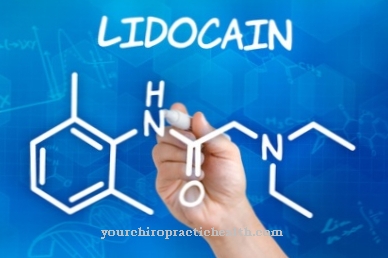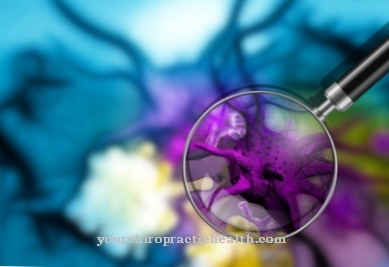At Potassium chloride is a potassium salt that is found in isotonic beverages and some medical products, among other things. In addition, it is one of the components of an electrolyte infusion and is indicated, for example, in ventricular fibrillation.
What is potassium chloride?

Potassium chloride (KCl) is the potassium salt of hydrochloric acid. The mineral is E508 approved in the EU as an additive for food; the industry uses it primarily as a flavor enhancer and firming agent. The names are also used in medicine Potassium chloratum or Potassium chloride common.
Potassium chloride is colorless and odorless and dissolves well in water. That is why it also functions as an electrolyte in the human body and as such is involved in homeostasis.
The substance is in its pure form in a solid state and forms cubic crystals. A potassium chloride molecule consists of a positively charged potassium particle and a negatively charged chloride particle. Not only medicine and the food industry make use of potassium chloride: in agriculture, for example, it can be found as a fertilizer.
Pharmacological effect
Potassium chloride is used in isotonic drinks and solutions to support the electrolyte balance. In a healthy adult, the blood contains around 300 mosmoles of inorganic electrolytes per liter, including potassium. Most of the osmotic substances in the organism are electrolytes. A lack of electrolytes disturbs the electrical balance as well as the water-electrolyte balance of the human body. In addition to other electrolytes, glucose, urea and other substances, potassium chloride contributes to homeostasis.
Potassium plays an important role in the functioning of nerve and other cells. Potassium ions are positively charged and thus contribute to the electrical balance of the cells.The osmotic pressure causes ions to flow into or out of the cell along the electrical charge gradient. For example, if the cell is negatively polarized, positively charged potassium ions and other particles automatically push into the interior. In doing so, they have to pass through the cell membrane, which consists of a double lipid layer. In the cell membrane there are not only ion channels through which the ions can migrate, but also pumps. The ion pumps transport charged atoms from one side of the membrane to the other. Biochemical signal substances determine whether the ion pumps are active or not - and how well the membrane is permeable to certain ions.
Medical application & use
Medicine uses potassium chloride when there is a potassium deficiency to replenish the body's potassium stores. In the case of cardiac fibrillation, intracardiac administration may be necessary. However, this decision is up to the attending physician. As with any medication intake, it also depends on the individual case with potassium chloride whether it makes sense or whether it can even cause damage.
Ventricular fibrillation is a specific type of heart rhythm disorder. Fibrillation is characterized by rapid ventricular contractions of the heart. The contractions follow one another regularly, with a frequency of about 250 per minute. The EKG makes these abnormalities visible.
Doctors usually administer potassium chloride intravenously to treat electrolyte imbalances when the concentration falls below a critical level. Prompt treatment is of great importance as a lack of potassium can lead to cardiac arrest. It may be necessary to use a central venous catheter. A central venous catheter is a thin tube that enters one of the body's most important veins on the collarbone. The tube leads to the right ventricle.
Ringer's solution, which can balance the fluid balance by means of infusion, also contains potassium chloride and other electrolytes. The purpose of the mixture is to ensure that the blood volume is not increased at the expense of the water-electrolyte balance.
Some toothpastes also contain potassium chloride. These special pastes are not only used to clean teeth, but also to relieve pain. The toothpastes are designed to reduce pain signals caused by irritation of the gums and teeth when brushing. Dentists often recommend such products to people who have very sensitive teeth. The special toothpaste is intended, among other things, to prevent those affected from stopping brushing because they find it too painful.
Homeopathy also uses preparations based on potassium chloride. The mineral is contained, among other things, in the Schüßler salt No. 4 in a highly diluted concentration.
You can find your medication here
➔ Medicines for cardiac arrhythmiasRisks & side effects
Potassium chloride can be highly toxic in very high doses, especially when injected directly. An overdose has the potential to lead to cardiac arrest. Because of this property, veterinarians use salt to euthanize animals. The lethal injection used in some countries to execute people also contains potassium chloride. The right dose is therefore essential. The amounts found in food are considered harmless.
However, not every excess of potassium chloride in the body leads to death. Characteristic signs of hyperkalemia are ringing in the ears, deafness, and confusion. Hallucinations, paresthesia, muscle weakness and tremors can also occur. The heart disorders make themselves felt in different ways: The pulse can slow down and beat irregularly. Hyperkalemia does not have to be the result of a potassium chloride overdose, but can also be due to massive hemolysis, kidney failure, or adynamia episodica hereditaria.
Medicine speaks of hyperkalemia when the potassium content in the blood serum is more than 5.0 mval per liter. However, myeloproliferative diseases can falsify the measured value. In the case of such an incorrect measurement, doctors speak of pseudohyperkalemia. The cause for this can be, for example, an increase in platelets. In such cases, the plasma is therefore more suitable as a test substance than the serum.
























.jpg)



